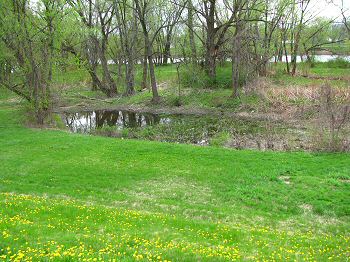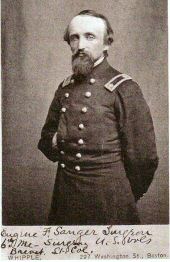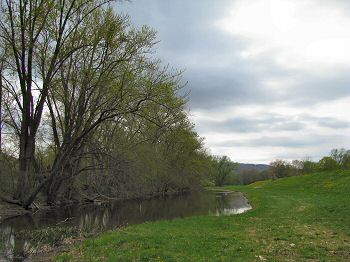 |
 |
|
|
(April 2009) Enlarge Hospital tents for prisoners with severe cases of diarrhea were between Foster's Pond and Chemung River |
(April 2009) Enlarge Col Eastman complained that the pond inside the camp had become a cesspool, that it was causing illness, and that something had to be done to remedy the situation immediately. "The drainage of the camp is into this pond or pool of standing water," agreed Post Surgeon Eugene F. Sanger during his inspection, "and one large sink used by the prisoners stands directly over the pond which receives its fecal matter hourly...Seven thousand men will pass 2,600 gallons of urine daily, which is highly loaded with nitrogenous material. A portion is absorbed by the earth, still a large amount decomposes on the top of the earth or runs into the pond to purify." One benefit Foster's Pond in it's deplorable, wretched, condition, however, was that it became a haven for an alternative food source... Rats quickly became part of the prison's complex bartering system. One rat could be traded for five chaws of tobacco, one haircut, or a number of other items |
|
|
|
||
 |
 |
|
|
(April 2009) Enlarge The "Dead House", was on the other side of this copse of trees. Close to 3,000 Confederates died here. March, 1865 held the highest death count for the camp. 491 prisoners died during this time. Each dead soldier had a small glass bottle placed in his armpit. A piece of paper with the soldiers information was placed in the bottle for further identification. John Jones, a runaway slave from Leesburg, Virginia and sexton of the Baptist Church in Elmira, was given the task of preparing the bodies for burial. He received $2.50 per burial |
(April 2009) Enlarge The medical staff went on to emphasize the problems with Foster's Pond..."This pond received the contents of the sinks and garbage of the camp until it became so offensive that vaults (sinks) were dug on the banks of the pond for sinks and the whole left a festering mass of corruption, impregnating the entire atmosphere of the camp with its pestilential odor, night and day...The pond remains green with putrescence, filling the air with its messengers of disease and death, the vaults (sinks) give out their sickly odors, and the hospitals are crowded with victims for the grave |
|
|
|
|
 Major
Eugene F. Sanger
Major
Eugene F. Sanger